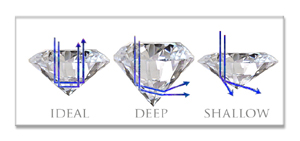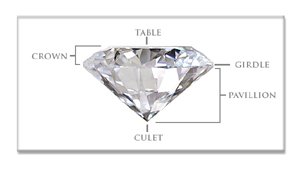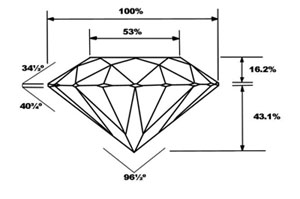The cut is crucial and critical to the brilliance, fire and scintillation of the stone. Cut is the single biggest factor affecting the brilliance and sparkle of your diamond. To learn more about this topic visit our cut page.
Commercial considerations are often made during the diamond cutting process in order to minimise the carat weight loss of the finished stone. For example, some diamond cutters will leave an excessively thick girdle around the stone, increasing the diamond’s carat weight. First time buyers tend to be unaware of the effect cut can have on the appearance of the diamond. Our expertise is to source those stones which have been cut to maximise brilliance, fire and scintillation. This is our passion.This illustration shows the various facets discussed in cut grade (referring to proportions).

Depth, width, angles and proportions are all aspects of cut that combine to affect the diamond’s grade. Modern technology makes it possible to take sophisticated computer measurements that model and replicate the behaviour of light in a diamond.
Cut is considered to be the most important factor with regard to the brilliance of a diamond.
There are two different types of light emanating from a diamond; brightness and fire. Together they influence the scintillation of a diamond.
Brightness - The return of white light to the human eye.
Fire - The return of coloured light to the human eye.
Scintillation - The movement of white and coloured light within a diamond as it is moved back and forth before an observer.
As a general rule, when a diamond has very good brightness and fire the scintillation will usually be very good as well. There is no single measurement of a diamond that defines its cut, rather a collection of measurements and observations that determine the relationship between a diamond's light performance, dimensions and finish. More recently GIA and other leading laboratories have introduced three separate classifications for these measurements for round brilliant diamonds.
Cut - refers to proportions.
Symmetry - refers to the alignment of the facets.
Polish - refers to the smoothness and lustre of the facets.

This can have an effect on how light travels within the diamond and how it exits in the form of brilliance.Ideal: Maximises light reflecting through the crown.
Too Deep: Light escapes out of the pavilion facets causing the diamond to appear dark and dull.
Too Shallow: Light is lost out of the pavilion facets causing the diamond to lose brilliance.

Symmetry refers to the precision of the cut pattern. Below are examples of different types of symmetry, each of which will have an effect on the brilliance, fire and scintillation of your diamond.
It is important to view the girdle thickness. If too thick the diamond will appear “built up” and look a little small for its weight. Extremely thin girdles may become abraded or chipped.

Polish is determined by the smoothness and lustre of the facet surfaces. Poor polish leads to a dull almost blurry appearance, whilst poor symmetry leads to reduced sparkle.